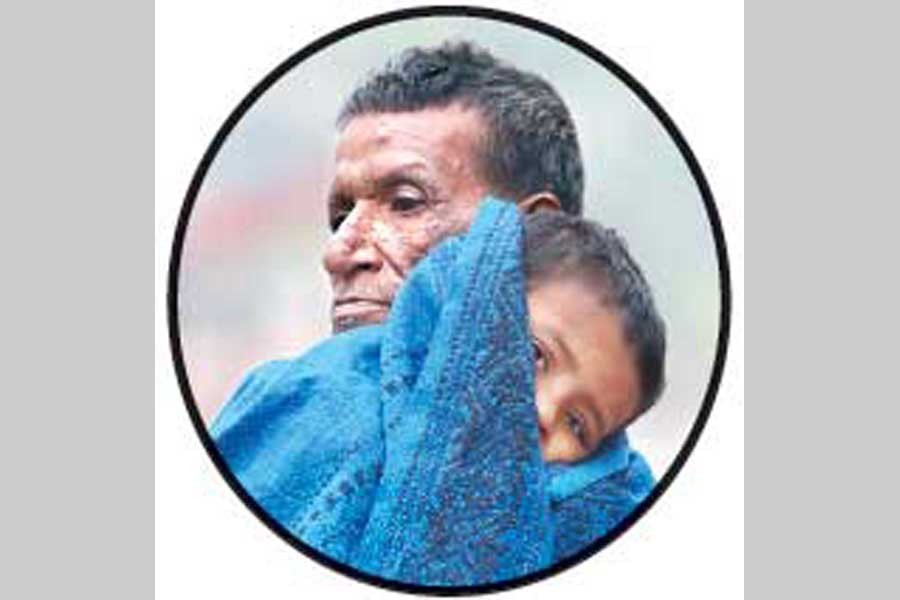Unlike Delhi, Kathmandu and a few other cities in South Asia, Dhaka nowadays experiences a mild winter. The present intensity of winter can be compared to that of Manila or Bangkok. This year, however, the winter reappeared with vengeance. Mercury dropped to around 12 degrees Celsius on some days in late December in Dhaka.
The country's northern region experienced mild cold waves causing immense sufferings to the elderly. In the past, deaths of a number of ultra-poor were a common phenomenon. In recent years, the frequency has kept declining. Nowadays, winter miseries seem less severe for the older people; the destitute segments in the northern region this year have been found leading a nearly normal life, with little disruptions.
The reason evidently was their prior preparations to face any severe winter bouts. Almost all the marginalised people were equipped with sufficient winter clothes. Over the last few decades, these specially made low-price local garments have been available throughout the country --- alongside the second-hand foreign jackets, pullovers, monkey caps etc. The government agencies have also been seen distributing blankets among the people for free. They were joined by different NGOs and charity organisations.
Severity of the Dhaka winter has come down considerably in the last one-and-half decades. In some years, the residents feel a mere drop in the city's scorching summer. The long-awaited season of winter remains elusive. The situation was completely different decades ago. The city and its suburbs would feel the bite of a bone-chilling winter every year. Beginning in early December, the season would continue up to early February. Thanks to Dhaka's densely grown trees and bushes, absence of traffic jams and thin population, the teeth of winter would literally cut deep into its normal life in those days.
In a prosaic view, the cold season visited Dhaka in the earlier times as a three-month period of sufferings -- especially for the poor. In fact, its people in general had to endure a punishing cold season, the mercury falling as low as 5.0 degrees Celsius in years in the capital. The average temperature in those days fluctuated between 7.0-10 degrees for weeks. This period of biting cold continued up to the 1970s-1980s.
Winters in the mid-1960s would descend on Dhaka with real ferocity. As years wore on, the extremity of winter kept reducing. Perhaps, that was the period of the mild onset of global warming.
However, elsewhere in the country, especially in the northern region, the mercury still dropped to a level bordering 2.0 degrees Celsius. However, those bouts of fall in temperature were viewed as an exception. Climatologists have attributed those isolated phenomena to erratic courses of global warming. They also called the mild and fleeting nature of winter in the country, Dhaka in particular, a feature of the global warming. It mainly stemmed from the release of carbon dioxide into the atmosphere in volumes much higher than experienced decades ago.
Climate experts are of the view that the changing seasonal patterns, like that of Bangladesh winter, are one of the pointers to an unsavoury reality: The impact of carbon emission-prompted climate change coupled with global warming is approaching the country faster than has been presumed. However, for a lower middle-income country like Bangladesh a fortnight to a month-long moderate winter also can exact a heavy toll on its people, especially those disadvantaged. But it's also true that following its graduation from the least developed country (LDC) status, the sufferings of the floating people during winter in Dhaka can now be coped with more efficiently than in the past. Thanks to the petty jobs with tolerably stable income and familial self-sufficiency, people shivering in makeshift shelters on winter nights are fast becoming a rare spectacle.
In the earlier days, scantily clothed street children would be seen sitting huddled together around fires made of dry twigs and roadside dry garbage to warm themselves up. Those scenes were integral to Dhaka roadsides; so were the scenes of charity organisations and the wealthy people distributing blankets among the elderly lying under roadside porticos and concrete sheds. These views are becoming rarer. In the near future, such spectacles might become a thing of the past. It's mostly because cheap warm clothes are not beyond the reach of even the extreme poor. People begging for used warm clothes house-to-house once were a common view in Dhaka. Nowadays, there are few such people. Even if there are some, they are mostly the new arrivals from villages.
A major aspect of Dhaka's winter is, despite having enough clothes the homeless people have to spend the chilly nights at nondescript corners of public and private office buildings. The luckier people who are long-time residents of the city rush to some common places well before evening. These places are more or less sufficiently warm, free of cost, and secure for women. These spots include Kamalapur and Tejgaon railway stations, Sadarghat launch terminal, public bus terminals, small bus sheds and garages.
Many people opt for abandoned and under-construction government buildings. The lack of places to spend the night can be termed a miserable headache for the floating people in Dhaka during winter. City authorities like that of Delhi run winter shelters. People can spend the wintry nights there for a nominal fee. This arrangement has provided a great relief for the winter-struck people in the Indian capital's urban areas. The two city corporations in Dhaka can embark on projects to set up winter shelters in every corner of the city. Since Delhi also experiences extreme heat during summer, the authorities convert these places into summer shelters with facilities for drinking water and bathing. Likewise, Dhaka's winter shelters can protect the poor from rain and flooding during prolonged monsoons.


